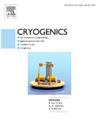Phase-field simulation of vortex dynamics in superconducting thin films under sinusoidal stress modulation
IF 2.1
3区 工程技术
Q3 PHYSICS, APPLIED
引用次数: 0
Abstract
This study investigates the dynamic behavior of magnetic flux lines in superconducting thin films under sinusoidal stress modulation via a phase-field model that couples the time-dependent Ginzburg-Landau (TDGL) equations with elasticity theory. The effects of strain amplitude, loading frequency, and pinning configurations on vortex dynamics, critical current efficiency, and critical temperature are systematically analyzed. Simulations show that low-frequency stress modulation enhances vortex trapping efficiency and critical current through strong vortex-pinning interactions, whereas high-frequency stress modulation induces phase lag and reduces efficiency. Moderate strain amplifies pinning gradients and increases vortex density, while excessive strain disrupts lattice uniformity. Periodic pinning arrangements achieve the highest trapping efficiency compared to random or graded distributions, attributed to uniform potential fields. The synergy between stress modulation and pinning density is quantified, identifying an optimal frequency and pinning parameters to maximize efficiency. The study further reveals the synergistic effects of dynamic stress and pinning density, and proposes an optimal combination of frequency and pinning parameters, offering a new perspective for enhancing the stability of superconducting thin films under dynamic stress.
正弦应力调制下超导薄膜涡旋动力学的相场模拟
本文研究了超导薄膜中磁通线在正弦应力调制下的动态行为,通过相场模型将时间相关的金兹堡-朗道(TDGL)方程与弹性理论相结合。系统分析了应变幅值、加载频率和钉接方式对涡流动力学、临界电流效率和临界温度的影响。仿真结果表明,低频应力调制通过强涡流钉钉作用提高了涡流捕获效率和临界电流,而高频应力调制引起相位滞后,降低了效率。适度的应变放大了钉钉梯度,增加了涡密度,而过大的应变破坏了晶格的均匀性。由于均匀的势场,与随机或梯度分布相比,周期性钉住安排实现了最高的捕获效率。量化了应力调制和钉钉密度之间的协同作用,确定了最佳频率和钉钉参数,以最大限度地提高效率。研究进一步揭示了动应力与钉扎密度的协同效应,并提出了频率与钉扎参数的最佳组合,为提高超导薄膜在动应力下的稳定性提供了新的视角。
本文章由计算机程序翻译,如有差异,请以英文原文为准。
求助全文
约1分钟内获得全文
求助全文
来源期刊

Cryogenics
物理-热力学
CiteScore
3.80
自引率
9.50%
发文量
0
审稿时长
2.1 months
期刊介绍:
Cryogenics is the world''s leading journal focusing on all aspects of cryoengineering and cryogenics. Papers published in Cryogenics cover a wide variety of subjects in low temperature engineering and research. Among the areas covered are:
- Applications of superconductivity: magnets, electronics, devices
- Superconductors and their properties
- Properties of materials: metals, alloys, composites, polymers, insulations
- New applications of cryogenic technology to processes, devices, machinery
- Refrigeration and liquefaction technology
- Thermodynamics
- Fluid properties and fluid mechanics
- Heat transfer
- Thermometry and measurement science
- Cryogenics in medicine
- Cryoelectronics
 求助内容:
求助内容: 应助结果提醒方式:
应助结果提醒方式:


